MODERATOR NOTE: a resource function based on this work is now available:
https://resources.wolframcloud.com/FunctionRepository/resources/ContentAwareImageResize/
- Update 1: Now forward energy is also implemented.
- Update 2: Now also extending an image has been implemented.
Seam carving

Hi All,
As you know Wolfram Language can do a lot of image processing, but one thing it can't yet do is so-called liquid rescaling. Liquid rescaling is a way of cropping the image but as opposed to ImageCrop it is content-aware. Meaning it will crop first parts of the image that have less 'information'. I'll show you how we can implement such cropping in Wolfram Language. We start of with importing an image:
img=Import["tower.png"];

I now define a so-called energy function that describes where the image is information-rich:
EnergyFunction[img_Image] := GradientFilter[img, 1, Method -> "ShenCastan"]
We can test this out:
EnergyFunction[img]
giving:
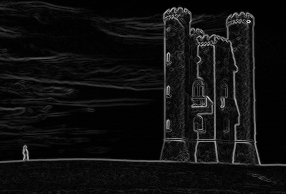
Now the idea is to find vertical 'seams' such that the sum of the values of the energy function along a seam is as low as possible. This seam contains the least of 'energy' or 'information' and we will therefore remove it first. We have to use the following code to do that:
MinFilter1[x_List] := Min /@ Partition[x, 3, 1, {2, 2}, 1.0 10^6] (* same as MinFilter[x,1] but 10x faster *)
MinPosition[x_List] := First[Ordering[x, 1]] (* position of min element *)
Neighbours[n_Integer?Positive, len_Integer?Positive] := Which[n == 1, If[len > 1, {1, 2}, {1}],
n == len, If[len > 1, {len, len - 1}, {1}],
True, {n - 1, n, n + 1}
]
FindSeam[mat_List?MatrixQ] :=
Module[{dimx, dimy, seam, neighbours, values, newpos, ii},
{dimy, dimx} = Dimensions[mat];
seam = ConstantArray[-1, dimy];
seam[[-1]] = MinPosition[mat[[-1]]];
Do[
neighbours = Neighbours[seam[[ii + 1]], dimx];
values = mat[[ii, neighbours]];
newpos = neighbours[[MinPosition[values]]];
seam[[ii]] = newpos
,
{ii, dimy - 1, 1, -1}
];
seam
]
ComputeEnergyField[img_Image] := FoldList[#2 + MinFilter1[#1] &, ImageData[EnergyFunction[img]]]
ComputeEnergyField[mat_List] := ComputeEnergyField[Image[mat]]
we can now test it out:
seam = FindSeam[ComputeEnergyField[img]];
HighlightImage[img, Transpose[{seam, Range[Length[seam]]}]]
seam will be a list of horizontal position of the pixel for each row of pixels. We can use HighlightImage to see the 'seam':

We can remove (carve) that seam from the original image, after which we can repeat this process over and over and crop 1 pixel each time until we have the width that we need (note that we need to recalculate the energy function after every carve). Of course one could do the same with horizontal seams if one wants to crop in the vertical direction. Simply use the same code but rotate the image 90 degrees, remove some seems, and then rotate is 90 degrees back.
To make it more interactive we can calculate all the seems and save these separately, after which we can very easily crop to a desired width:
ClearAll[MinFilter1, MinPosition, Neighbours, FindSeam, EnergyFunction, ComputeEnergyField, Carve, FillNthPosition, CreateSeamcarveImageData, SeamCarve]
MinFilter1[x_List] := Min /@ Partition[x, 3, 1, {2, 2}, 1.0 10^6] (* same as MinFilter[x,1] but 10x faster *)
MinPosition[x_List] := First[Ordering[x, 1]] (* position of min element *)
Neighbours[n_Integer?Positive, len_Integer?Positive] := Which[n == 1, If[len > 1, {1, 2}, {1}],
n == len, If[len > 1, {len, len - 1}, {1}],
True, {n - 1, n, n + 1}
]
FindSeam[mat_List?MatrixQ] :=
Module[{dimx, dimy, seam, neighbours, values, newpos, ii},
{dimy, dimx} = Dimensions[mat];
seam = ConstantArray[-1, dimy];
seam[[-1]] = MinPosition[mat[[-1]]];
Do[
neighbours = Neighbours[seam[[ii + 1]], dimx];
values = mat[[ii, neighbours]];
newpos = neighbours[[MinPosition[values]]];
seam[[ii]] = newpos
,
{ii, dimy - 1, 1, -1}
];
seam
]
EnergyFunction[img_Image] := GradientFilter[img, 1, Method -> "ShenCastan"]
ComputeEnergyField[img_Image] := FoldList[#2 + MinFilter1[#1] &, ImageData[EnergyFunction[img]]]
ComputeEnergyField[mat_List] := ComputeEnergyField[Image[mat]]
Carve[mat_List?ArrayQ, seam_List] := MapThread[Delete, {mat, seam}, 1]
FillNthPosition[x_List, n_Integer?Positive, fill_, empty_: 0] :=
Block[{pos, out},
out = x;
pos = Position[out, empty, {1}, n, Heads -> False];
out[[pos[[n]]]] = fill;
out
]
CreateSeamcarveImageData[img_Image] := Block[{imagedata, dims, dimx, dimy, carveinfo, seam, energyinfo},
imagedata = ImageData[img];
dims = {dimy, dimx} = Dimensions[imagedata, 2];
carveinfo = ConstantArray[0, dims];
PrintTemporary[Dynamic[Row[{"Calculating: ", i, "/", dimx}]]];
Do[
energyinfo = ComputeEnergyField[imagedata];
seam = FindSeam[energyinfo];
carveinfo =
MapThread[FillNthPosition[#1, #2, i, 0] &, {carveinfo, seam}];
imagedata = Carve[imagedata, seam];
,
{i, dimx}
];
{img, carveinfo}
]
SeamCarve[{img_Image, carveinfo_List}, n_Integer?NonNegative] := Block[{imgdata, pick, sel, m},
imgdata = ImageData[img];
If[Dimensions[imgdata, 2] == Dimensions[carveinfo],
m = Clip[n, {0, Length[carveinfo[[1]]] - 1}];
sel = UnitStep[m - carveinfo];
Image[Pick[ImageData[img], sel, 0]]
,
Abort[];
]
]
Now we pre-calculate the positions of the seams:
out = CreateSeamcarveImageData[img];
Manipulate[SeamCarve[out, n], {n, 0, 500, 1}]

We can now interactively change the width without cropping essential features away. To give you a comparison, here I cut away 100 pixels (from 286 pixels to 186 pixels) using different methods:
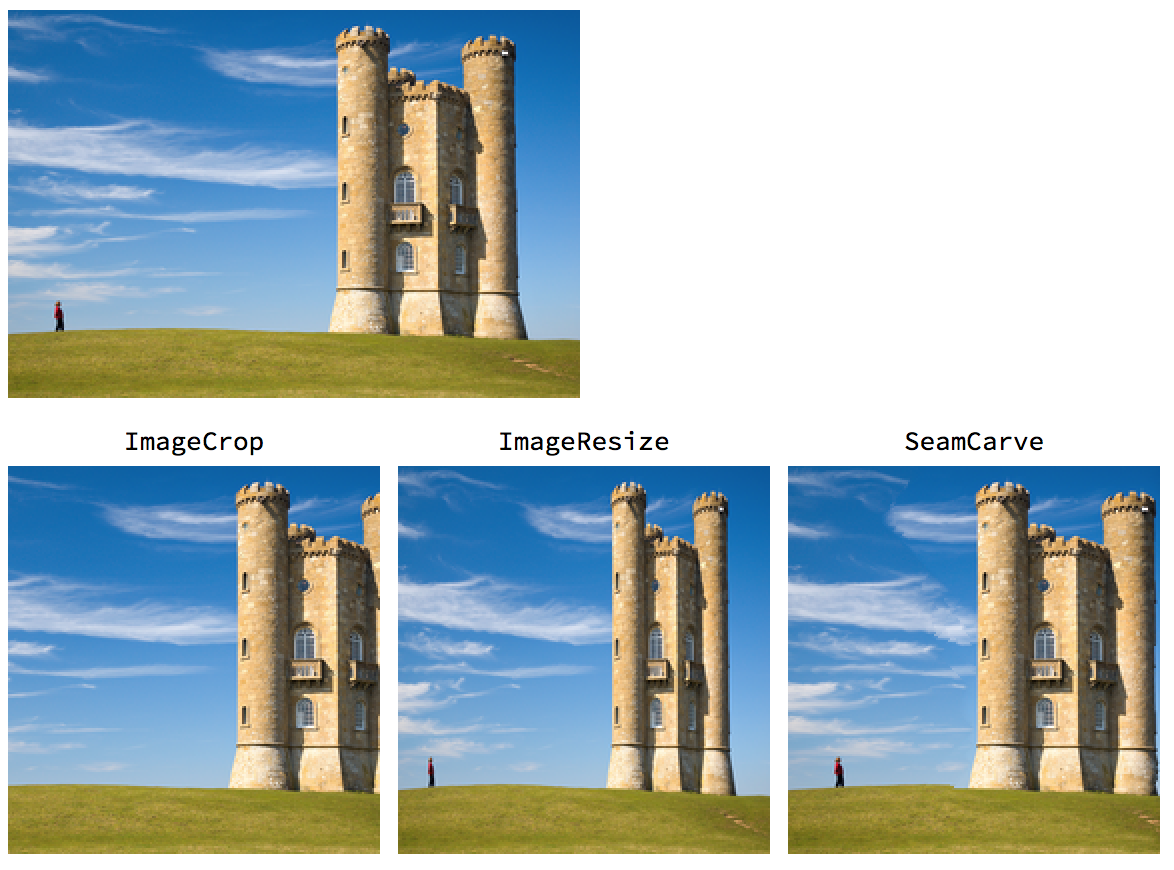
To give you a better idea of what the seams are I show you the seam information:
Image[Rescale[out[[2]]]]
Colorize[out[[2]]]
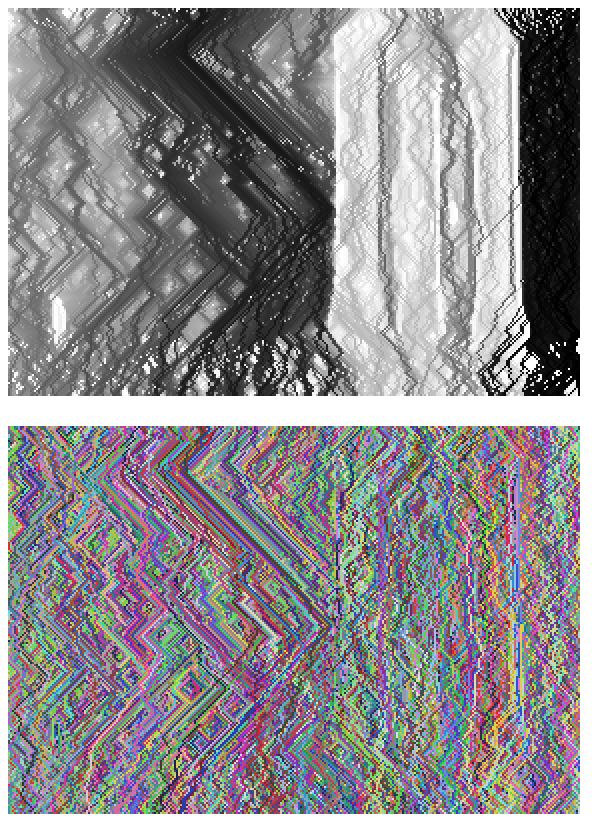
Where (in the top figure) dark colors mean seams that will be removed first, while brighter seams are left for last. You can clearly see that the tower and the person are saved until the last. Using this code we can now crop the width of any picture.
Object removal
But we can extend this method: say that we want to remove an object from an image. We can use the same algorithm but now we use extra negative weight to the region we want to delete. Say we have the following image:

and we would like to remove the guy on the left. We create a mask that includes his shadow:

We update our code to include a negative mask:
ClearAll[ComputeEnergyFieldNegativeMask, CreateSeamcarveImageDataNegativeMask]
ComputeEnergyFieldNegativeMask[img_Image, mask_Image] := FoldList[#2 + MinFilter1[#1] &, ImageData[EnergyFunction[img]] - 10000 ImageData[mask]]
ComputeEnergyFieldNegativeMask[mat_List, mask_List] := ComputeEnergyFieldNegativeMask[Image[mat], Image[mask]]
CreateSeamcarveImageDataNegativeMask[img_Image, mask_Image] := Block[{maskdata, imagedata, dims, dimx, dimy, carveinfo, seam,
energyinfo}, (* removal *)
If[ImageDimensions[img] == ImageDimensions[mask],
imagedata = ImageData[img];
maskdata = ImageData[ColorConvert[mask, "Grayscale"]];
dims = {dimy, dimx} = Dimensions[imagedata, 2];
carveinfo = ConstantArray[0, dims];
PrintTemporary[Dynamic[Row[{"Calculating: ", i, "/", dimx}]]];
Do[
energyinfo = ComputeEnergyFieldNegativeMask[imagedata, maskdata];
seam = FindSeam[energyinfo];
carveinfo =
MapThread[FillNthPosition[#1, #2, i, 0] &, {carveinfo, seam}];
imagedata = Carve[imagedata, seam];
maskdata = Carve[maskdata, seam];
,
{i, dimx}
];
{img, carveinfo}
,
Abort[];
]
]
Now trying out the code:
img = Import["beachpeeps.jpg"];
mask = Import["beachpeepsmask.png"];
AbsoluteTiming[out = CreateSeamcarveImageDataNegativeMask[img, mask];]
Manipulate[SeamCarve[out, n], {n, 0, 75, 1}]

Or a static comparison:
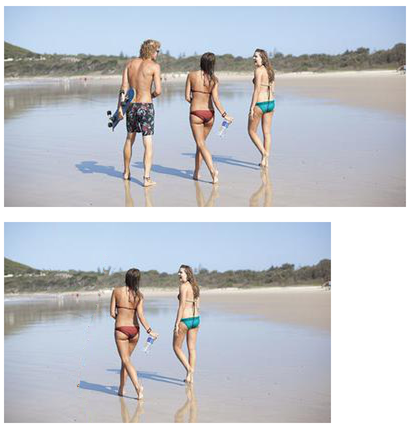
Object protection
In the same spirit, we can protect certain areas in the image that are important to us:
ClearAll[CreateSeamcarveImageDataPositiveMask, ComputeEnergyFieldPositiveMask]
ComputeEnergyFieldPositiveMask[img_Image, mask_Image] := FoldList[#2 + MinFilter1[#1] &, ImageData[EnergyFunction[img]] + 10000 ImageData[mask]]
ComputeEnergyFieldPositiveMask[mat_List, mask_List] := ComputeEnergyFieldPositiveMask[Image[mat], Image[mask]]
CreateSeamcarveImageDataPositiveMask[img_Image, mask_Image] := Block[{maskdata, imagedata, dims, dimx, dimy, carveinfo, seam,
energyinfo}, (* removal *)
If[ImageDimensions[img] == ImageDimensions[mask],
imagedata = ImageData[img];
maskdata = ImageData[ColorConvert[mask, "Grayscale"]];
dims = {dimy, dimx} = Dimensions[imagedata, 2];
carveinfo = ConstantArray[0, dims];
PrintTemporary[Dynamic[Row[{"Calculating: ", i, "/", dimx}]]];
Do[
energyinfo = ComputeEnergyFieldPositiveMask[imagedata, maskdata];
seam = FindSeam[energyinfo];
carveinfo =
MapThread[FillNthPosition[#1, #2, i, 0] &, {carveinfo, seam}];
imagedata = Carve[imagedata, seam];
maskdata = Carve[maskdata, seam];
,
{i, dimx}
];
{img, carveinfo}
,
Abort[];
]
]
Where now our mask includes all the 3 persons in the image, including there shadows:

Again, we call our function:
img = Import["beachpeeps.jpg"];
mask = Import["beachpeepsmask2.png"];
AbsoluteTiming[out = CreateSeamcarveImageDataPositiveMask[img, mask];]
Manipulate[SeamCarve[out, n], {n, 0, 500, 1}]
Giving:

Or some static comparisons:
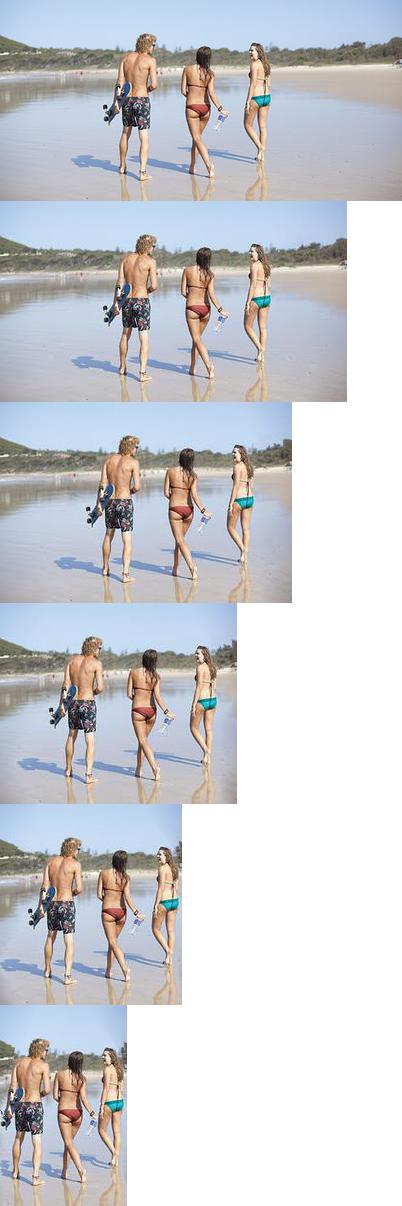
Final thoughts
For the energy-function we can use different functions, I used a simple (fast) GradientFilter, but other functions like ImageSaliencyFilter or EntropyFilter could also work. Seams now go from top to bottom, and the position of the seam changes at most 1 horizontal position per row of pixels, this can be changed without too much effort to be a bigger neighbourhood. Also this can be applied to videos but a 3-dimensional carve in space-time has to be calculated. Moreover, the energy function can be improved by including 'forward energy'. I can't wait for this functionality to be included in the Wolfram Language.
EDIT:
See my reply below, on how to implement forward energy.
P.S. I'm still confused why the guy has a skateboard on the beach...